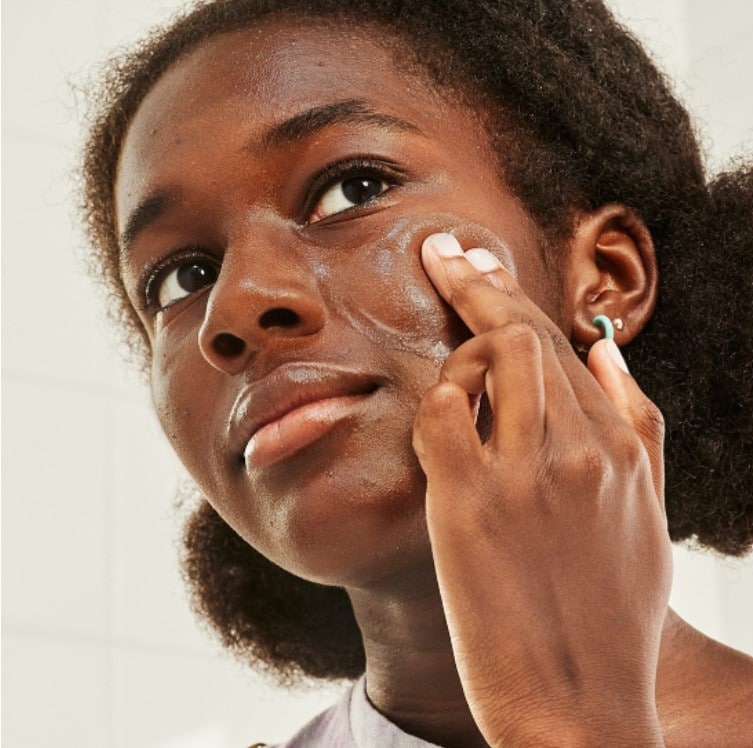
How to Choose Between Tinted Moisturizer & Foundation
![]()
A few decades ago, your only option for covering up uneven (and maybe breakout-prone) skin was a thick, cakey foundation. These days, there are a lot more options when it comes to coverage, from high-quality foundations to smooth, silky tinted moisturizers. But what are the pros and cons of each, and how can you decide which one is right for your skin? Here’s everything you need to know.
What is Tinted Moisturizer?
A tinted moisturizer is a moisturizing makeup product used for light to medium coverage. “A tinted moisturizer is meant to enhance one’s complexion and is not designed to be used as a moisturizer in your regular skincare routine,” explains Cosmetic Dermatologist Dr. Michele Green.
In other words, while it offers moisturizing benefits on top of coverage, it shouldn’t replace your regular moisturizer.
Benefits of tinted moisturizer
One of the top benefits of a tinted moisturizer is that on top of providing light to medium coverage, it will also moisturize your skin. “Most formulas are packed with humectant moisturizing ingredients,” explains Dr. Green. “Humectants draw moisture from the atmosphere and encourage moisture retention within the skin, providing a hydrating effect and a radiant, healthy glow.
Cons of tinted moisturizer
The only real con to a tinted moisturizer is that it won’t offer heavy coverage. So if you’re looking for more coverage, you might want to opt for a foundation.
What type of skin is it suitable for?
According to Dr. Green, tinted moisturizers are suitable for all skin types. “Tinted moisturizers are available in varying finishes and formulas, meaning that no matter what skin type you have, there is a tinted moisturizer that will suit your skin,” she explains. “Individuals who have oily skin and are prone to acne breakouts should select a tinted moisturizer that is non-comedogenic. If a skincare product is labeled as non-comedogenic, it indicates that it won’t clog the pores, helping to prevent acne breakouts from occurring. Those who have dry skin should instead opt for a tinted moisturizer that contains hydrating skincare ingredients.”
Not sure what type of skin you have? “To determine your skin type, wash your skin with a gentle cleanser. Without applying any skincare products, your natural skin texture and tone will give you clues as to what skin type you have,” suggests Dr. Green. “Check the appearance of your skin several hours after washing. If you’re shiny, you have oily skin. If you’re flaky, red, or irritated, you have dry skin. Having patches of oily and dry skin means that you have combination skin. Normal skin won’t be dry or flaky but will look and feel hydrated and healthy.”
What is Foundation?
Foundation is a makeup product meant to provide a base, or foundation, for the rest of your makeup. “Foundation provides medium to full coverage and creates an even-toned complexion,” explains Dr. Green.
Stumped as to what the difference between tinted moisturizer and foundation is? Here’s everything you need to know.
Benefits of foundation
The main benefit of foundation, according to Dr. Green, is that “it will provide full coverage and help to camouflage the appearance of areas of facial hyperpigmentation such as age spots that a product like a tinted moisturizer won’t be able to conceal.”
Cons of foundation
If you’re prone to breakouts or acne, it’s important to be very careful when choosing a foundation, because the wrong foundation can worsen any existing issues related to breaking out.
“Individuals who are prone to acne may find that many foundations cause comedonal acne as a result of the pores becoming clogged,” explains Dr. Green. “Individuals with dry skin may notice that many foundations make their skin appear flaky and uneven. The key to preventing skin irritation and acne lesions from developing is to find a foundation or tinted moisturizer that caters to the unique needs of your skin type.”
What type of skin is it suitable for?
Foundation is suitable for all skin types, according to Dr. Green, but it’s important to carefully read ingredients to make sure the foundation you choose won’t irritate your skin, cause breakout, the list goes on.
Final Thoughts on Tinted Moisturizers vs Foundation
So, is tinted moisturizer better than foundation, or vice versa? Dr. Green says it’s not as simple as that — it all comes down to your preference around use of makeup, both from a coverage and skincare perspective.
“So long as the product is used correctly and the chosen foundation or tinted moisturizer is appropriate for the user’s skin type, either product is okay for use,” she says. “A makeup or skincare product can potentially cause skin irritation or acne breakouts if the formula of the product is not suited to the skin type of the user. In other words, neither a tinted moisturizer or a foundation is inherently bad for your skin health unless the product is not meant to be used with your skin type.”
*All referenced results are based on an 8-week U.S. clinical and consumer study.
Learn more about Rodan + Fields and how you can get your most radiant skin ever. Trust your skin’s glow to the Doctors and to your consultant who know how to help you get your skin glowing.
Results may vary depending on multiple factors: age, gender, skin type and condition, concomitant products used, health history, location, lifestyle,
Share this with friends or family members. It will save their skin — and boost their confidence.
PM me for the best options to suit your budget 🙂
*information is taken from The Skincare Source.










